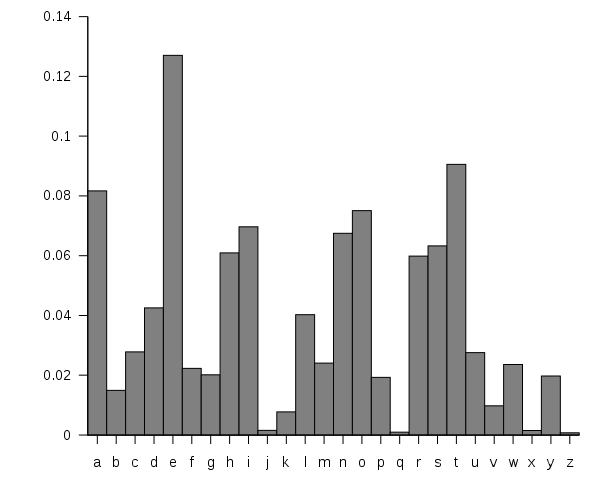

The Simple Substitution Cipher is one of the most generalized substitution ciphers. In essence, each letter of the alphabet is to be replaced by something - a picture, an symbol, a number, or for our cases, another letter. These letters can be replaced at random, or possibly have a "key" that creates a specially randomized alphabet. The Caesar cipher and Atbash cipher are both special cases of how one can scramble an alphabet in a simple substitution. An example of an simple substitution cipher is in one of Arthur Conan Doyle's Sherlock Holmes' stories, The Adventures of the Dancing Men.
Encoding for the simple substitution is just like the Caesar and Atbash ciphers - use your plaintext alphabet to find the letter you want to encrypt. Look below to its corresponding letter in the ciphertext akphabet. Write the ciphertext letter down.
Decoding Simple Subsition works in entirely the same way, except backwards. Insread of checking the plaintext alphabet first, a decryptor will look for their letter within the ciphertext alphabet, and then write down its corresponding plaintext letter above.
Breaking Simple Subsition, unlike Caesar and Atbash, is not as easy. One of the reasons for this increased difficulty is the amount of possible combinations for the alphabet to be organized in. However, that does not mean the the Simple Substitution cipher is infalliable. Frequency Analysis is often the term used to describe how simple substitution cipher are broken. When you think about it, if we only replace the letters of the alphabet with one unique character, then the frequency of letters that show up on the ciphertext should correspond to some percentage of letters that occur in English. For instance, given a large enough paragraph, the most common letter could be inferred to be an E, due to the similar occurrences. Given even longer passages in simple substitution, patterns will begin to appear with groups of letters.
Plaintext: a b c d e f g h i j k l m n o p q r s t u v w x y z
Ciphertext: P H Q G I U M E A Y L N O F D X J K R C V S T Z W B (random)
Ciphertext: C I P H E R A B D F G J K L M N O Q S T U V W X Y Z (key)
Plaintext: CRYPTOLOGY IS COOL
Ciphertext: QKWXCDNDMW AR QDDN (random)
Ciphertext: PQYNTMJMAY DS PMMJ (key)

Example 1: Decipher SN AE, NQ KNS SN AE--SCHS DR SCE PUERSDNK:
WCESCEQ 'SDR KNAIEQ DK SCE JDKL SN RUTTEQ
SCE RIDKBR HKL HQQNWR NT NUSQHBENUR TNQSUKE
NQ SN SHGE HQJR HBHDKRS H REH NT SQNUAIER
HKL AY NOONRDKB EKL SCEJ. Example 2: Decipher VJPFJ EUTVU JNJXS JEFHT UTFJZ HBNHZ BCCCB AJBDB DRTXV FHJQD
BFJUP FTFJP KRTXJ EBNTZ TPPQU UJDCV TDUUJ CBSJE TFJCV TFFTN
OJUSV DTATC TDUTB ERKEN JPKRF HJJXW BEJKR MTWTD
WHETHER 'TIS NOBLER IN THE MIND TO SUFFER
THE SLINGS AND ARROWS OF OUTRAGEOUS FORTUNE
OR TO TAKE ARMS AGAINST A SEA OF TROUBLES
AND BY OPPOSING END THEM.
- William Shakespeare, Hamlet
Simple Substitution cipher often have a way of finding themselves into popular media. They have often been used as a treat for fans of Futurama and Gravity Falls, for instance. But two of the most popular simple substitution ciphers are found in Edgar Allen Poe's short story, The Gold-Bug, and one of Sir Arthur Conan Doyle's "Sherlock Holmes" stories, The Adventure of the Dancing Men.
Below are the two ciphers used in them. I won't give the answers or context, you'll just have to read the stories for yourself to find out.
53‡‡†305))6*;4826)4‡.)4‡);806*;48†8
¶60))85;;]8*;:‡*8†83(88)5*†;46(;88*96
*?;8)*‡(;485);5*†2:*‡(;4956*2(5*—4)8
¶8*;4069285);)6†8)4‡‡;1(‡9;48081;8:8‡
1;48†85;4)485†528806*81(‡9;48;(88;4
(‡?34;48)4‡;161;:188;‡?;

Perhaps, as a young child, many of you encountered the Pigpen Cipher, picured below. The Pigpen Cipher is another form of simple subsitution cipher, only it uses a letter's location in a grid as the subsitution element.


This application to come soon